Analysis of Spatio-Temporal Variation Characteristics of Air Pollutants in Zaozhuang China from 2018 to 2022
Abstract
1. Introduction
2. Data and Methods
2.1. Data Preprocessing
2.2. Kriging Interpolation Method
2.3. Mann–Kendall Test and Sen’s Slopes
3. Results and Discussion
3.1. Spatio-Temporal Variation Characteristics
3.1.1. Basic Status of Air Pollutants
3.1.2. Interannual Variation Characteristics
3.1.3. Seasonal Variation Characteristics
3.1.4. Monthly Variation Characteristics
3.1.5. Weekly Variation Characteristics
3.1.6. The Result of the Mann–Kendall Test and the Detection of Extreme Pollution Events
3.1.7. Spatial Distribution Characteristics
3.2. Influencing Factors
3.2.1. Analysis of Meteorological Parameters
3.2.2. The Results of Time-Series Decomposition and Wavelet Transform
3.2.3. Correlation Between PM10 and Precipitation
4. Conclusions and Prospect
4.1. Conclusions
- (1)
- The concentration of air pollutants in Zaozhuang City generally showed a decreasing trend from 2018 to 2022. NO2, SO2, PM2.5, and PM10 concentrations decreased by 17.3%, 52.2%, 28.9%, and 33.6%, respectively, in 2022 compared with 2018, while the concentration of O3 in 2022 was 2.5% higher than that in 2018. From the perspective of seasonal variation, the concentrations of SO2, PM2.5, PM10, CO, and NO2 were the highest in winter and the lowest in summer. The O3 concentration is distributed from high to low in summer, spring, autumn, and winter.
- (2)
- The monthly changes in SO2, CO, NO2, PM2.5, and PM10 were U-shaped. High values were concentrated in December and January, while low values were concentrated in June, July, August, and September. The monthly variation in O3 showed a bimodal variation. It peaked in June and September. The maximum daily average concentrations of CO, NO2, SO2, PM2.5, and PM10 all appeared on Monday, and the daily average concentration was basically higher on weekdays than on weekends.
- (3)
- The spatial distribution characteristics of NO2, CO, PM2.5, and PM10 were basically the same, that is, they gradually decreased from the south to the north, and the lowest values mostly appeared in the Shanting area. The high O3 and SO2 values were distributed in the economically developed and industrialized Shizhong District, Xuecheng District, and Tengzhou City.
- (4)
- All the pollutants were almost negatively correlated with the wind speed. The main reason is that, when the wind speed is high, it is conducive to the diffusion of pollutants.
4.2. Recommendations
- (1)
- Enhanced monitoring density and prediction accuracy
- (2)
- Strengthen early-warning publicity
- (3)
- Call on enterprises to reduce emissions and strengthen supervision
4.3. Prospect
Author Contributions
Funding
Institutional Review Board Statement
Informed Consent Statement
Data Availability Statement
Conflicts of Interest
References
- Wang, C.; Guo, J.; Liu, J. Green roofs and their effect on architectural design and urban ecology using deep learning approaches. Soft Comput. 2024, 28, 3667–3682. [Google Scholar] [CrossRef]
- Yan, J.; Geng, J.; Su, F. Estimation of the Ecosystem Service Value of the Yellow River Delta-Laizhou Bay Coastal Zone Considering Regional Differences and Social Development. Environ. Manag. 2024, 74, 192–205. [Google Scholar] [CrossRef] [PubMed]
- Bin, X.; Zhong, Y.; Bin, J.L. Research on the control of overburden deformation by filling ratio of cementing filling method with continuous mining and continuous backfilling. Environ. Sci. Pollut. Res. 2023, 30, 26764–26777. [Google Scholar] [CrossRef]
- Shen, F.; Song, L.; Min, J.; He, Z.; Shu, A.; Xu, D.; Chen, J. Impact of assimilating pseudo-observations derived from the “Z-RH” relation on analyses and forecasts of a strong convection case. Adv. Atmos. Sci. 2025, 42, 1010–1025. [Google Scholar] [CrossRef]
- Shu, A.; Shen, F.; Li, H.; Min, J.; Luo, J.; Xu, D. Impacts of assimilating polarimetric radar KDP observations with an ensemble Kalman filter on analyses and predictions of a rainstorm associated with Typhoon Hato (2017). Q. J. R. Meteorol. Soc. 2025, 17, e4943. [Google Scholar] [CrossRef]
- Zheng, Y.; Kolditz, O.; Ma, K.Y. Environmental earth sciences: Advancing geosphereplus knowledge for environmental problem solving. Environ. Earth Sci. 2023, 82, 445. [Google Scholar] [CrossRef]
- Guo, Q.; Wang, Y.; Zhang, Y.; Yi, M.; Zhang, T. Environmental migration effects of air pollution: Micro-level evidence from China. Environ. Pollut. 2022, 292 Pt A, 118263. [Google Scholar] [CrossRef]
- Zhang, J.; Luo, L.; Chen, G.; Ai, B.; Wu, G.; Gao, Y.; Lip, G.; Lin, H.; Chen, Y. Associations of ambient air pollution with incidence and dynamic progression of atrial fibrillation. Sci. Total Environ. 2024, 951, 175710. [Google Scholar] [CrossRef]
- Kara, Y.; Evik, S.E.Y.; Toros, H. Comprehensive analysis of air pollution and the influence of meteorological factors: A case study of Adiyaman province. Environ. Monit. Assess. 2024, 196, 525. [Google Scholar] [CrossRef]
- Maltby, T.; Birch, S.; Fagan, A.; Subai, M. What is the role of activism in air pollution politics? understanding policy change in Poland. Environ. Plan. C Politics Space 2024, 42, 1332–1351. [Google Scholar] [CrossRef]
- Shen, L.; Yang, Z.; Du, X.; Wei, X.; Chen, X. A health risk-based threshold method to evaluate urban atmospheric environment carrying capacity in Beijing-Tianjin-Hebei (bth) region. Environ. Impact Assess. Rev. 2022, 92, 106692. [Google Scholar] [CrossRef]
- Liu, P.; Shao, L.; Li, Y.; Jones, T.; Cao, Y.; Yang, C.X.; Zhang, M.; Santosh, M.; Feng, X.; Bérubé, K. Microplastic atmospheric dustfall pollution in urban environment: Evidence from the types, distribution, and probable sources in Beijing, China. Sci. Total Environ. 2022, 838, 155989. [Google Scholar] [CrossRef] [PubMed]
- Guo, J.; Li, Z.; Zhang, B. Interaction patterns between economic growth and atmospheric environment in China under the “carbon neutrality” target. Environ. Sci. Pollut. Res. 2023, 30, 98231–98245. [Google Scholar] [CrossRef] [PubMed]
- Zhu, D.; Liang, G. Atmospheric pollution status quo and prevention proposals in Zaozhuang city. J. Environ. Manag. Coll. China 2014, 24, 18–20+45. [Google Scholar] [CrossRef]
- Liu, Y.; Wang, M.; Gui, C. Spatial and temporal distribution characteristics and correlation analysis of PM2.5 in urban agglomeration of China’s industrial base. Sci. Technol. Eng. 2018, 18, 184–189. [Google Scholar] [CrossRef]
- Ma, M.; Yang, X.; Ding, F. Spatial and temporal distribution of air pollutants in northern and southern China. Environ. Sci. Technol. 2018, 41, 187–197. [Google Scholar] [CrossRef]
- Chen, S.; Wang, C.; Xie, T. Distribution characteristics of atmospheric particulate matter in cold and warm seasons in mainland China in 2014. J. Lanzhou Univ. 2018, 54, 167–174+183. [Google Scholar] [CrossRef]
- Zang, X.; Lu, G.; Yao, H. Research on the spatiotemporal distribution characteristics of major atmospheric pollutants in China. J. Ecol. Environ. 2015, 24, 1322–1329. [Google Scholar] [CrossRef]
- Li, X.; Abdullah, L.; Sobri, S.; Said, M.; Hussain, S.; Tan, P.; Hu, J. Long-term air pollution characteristics and multi-scale meteorological factor variability analysis of mega-mountain cities in the Chengdu-Chongqing economic circle. Water Air Soil Pollut. 2023, 234, 328. [Google Scholar] [CrossRef]
- Zhang, L.; Xu, X.; Zhang, Y.; Zhang, X.; Wu, J.; Sheng, X.; Chen, F.; Chen, L.; Ge, X.; Wu, H. Characteristics of air pollution complex in a typical chemical industrial development zone in eastern China. Atmos. Environ. 2024, 319, 120274. [Google Scholar] [CrossRef]
- Li, J. Structural characteristics and evolution trend of collaborative governance of air pollution in “2 + 26” cities from the perspective of social network analysis. Sustainability 2023, 15, 5943. [Google Scholar] [CrossRef]
- Guan, J.; Geng, Z.; Yang, F.; Zhang, X.; Chen, S.; Guo, Y. Analysis on temporal variation law of ozone pollution and meteorological driving factors in pudong new area of Shanghai. Environ. Prog. Sustain. Energy 2023, 42, e14089. [Google Scholar] [CrossRef]
- Wang, J.; Zhao, Y.; Xu, M. Distribution characteristics of six criteria air pollutants under different air quality levels in Cangzhou city, China. J. Health Environ. Res. 2022, 8, 9–15. [Google Scholar] [CrossRef]
- Matheron, G. Principles of geostatistics. Econ. Geol. 1963, 58, 1246–1266. [Google Scholar] [CrossRef]
- Hock, R.; Jensen, H. Application of kriging interpolation for glacier mass balance computations. Geogr. Ann. Ser. A Phys. Geogr. 1999, 81, 611–619. [Google Scholar] [CrossRef]
- Zhang, S.; Wan, Z.; Wang, X.; Xu, A.; Chen, Z. Analysis of Flight Loads during Symmetric Aircraft Maneuvers Based on the Gradient-Enhanced Kriging Model. Aerospace 2024, 11, 334. [Google Scholar] [CrossRef]
- Gocic, M.; Trajkovic, S. Analysis of changes in meteorological variables using Mann-Kendall and Sen’s slope estimator statistical tests in Serbia. Glob. Planet. Change 2013, 100, 172–182. [Google Scholar] [CrossRef]
- Zhang, X.; Xu, D.; Shen, F.; Min, J. Impacts of offline nonlinear bias correction schemes using the machine learning technology on the all-sky assimilation of cloud-affected infrared radiances. J. Adv. Model. Earth Syst. 2024, 16, e2024MS004281. [Google Scholar] [CrossRef]
- Zhang, X.; Xu, D.; Min, J.; Li, H.; Shen, F.; Lei, Y. A Machine Learning-based Bias Correction Scheme for the All-Sky Assimilation of AGRI Infrared Radiances in a Regional OSSE Framework. IEEE Trans. Geosci. Remote Sens. 2024, 62, 5407314. [Google Scholar] [CrossRef]
- Kamińska, J. The use of random forests in modelling short-term air pollution effects based on traffic and meteorological conditions: A case study in Wrocaw. J. Environ. Manag. 2018, 217, 164–174. [Google Scholar] [CrossRef]
- Kamińska, J.; Turek, T. Explicit and implicit description of the factors impact on the NO2 concentration in the traffic corridor. J. Environ. Sci. Eng. 2023, 12, 456–478. [Google Scholar] [CrossRef]
- Bai, Y.; Qi, H.; Zhao, T.; Yang, H.; Liu, L.; Cui, C. Analysis of meteorological conditions and diurnal variation characteristics of PM2.5 heavy pollution episodes in the winter of 2015 in Hubei province. Acta Meteorol. Sin. 2018, 76, 803–815. [Google Scholar] [CrossRef]
- Zhou, H.; Li, X.; Liu, Y.; Tian, X.; Wen, J. Wet Scavenging Effect of Precipitation on PM2.5 Concentration in Langfang of Hebei Province. Environ. Prot. Sci. 2020, 46, 70–75. [Google Scholar] [CrossRef]
- Yu, C.; Deng, X. The scavenging effect of precipitation and wind on PM2.5 and PM10. J. Environ. Sci. 2018, 38, 4620–4629. [Google Scholar] [CrossRef]
- Zhang, D. Study on Reducing Effect of Artificial Precipitation on Concentration of Atmospheric Particulate Pollutants. Environ. Sci. Manag. 2021, 46, 43–47. [Google Scholar] [CrossRef]
- Liao, D.; Xiang, B.; Liu, Y. Study on the Correlation Between Meteorological Elements and Air Quality in Chongqing. Environ. Impact Assess. 2020, 42, 75–80. [Google Scholar] [CrossRef]
- Luan, T.; Guo, X.; Zhang, T.; Guo, L. The scavenging process and physical removing mechanism of pollutant aerosols by different precipitation intensities. J. Appl. Meteorol. Sci. 2019, 30, 279–291. [Google Scholar] [CrossRef]
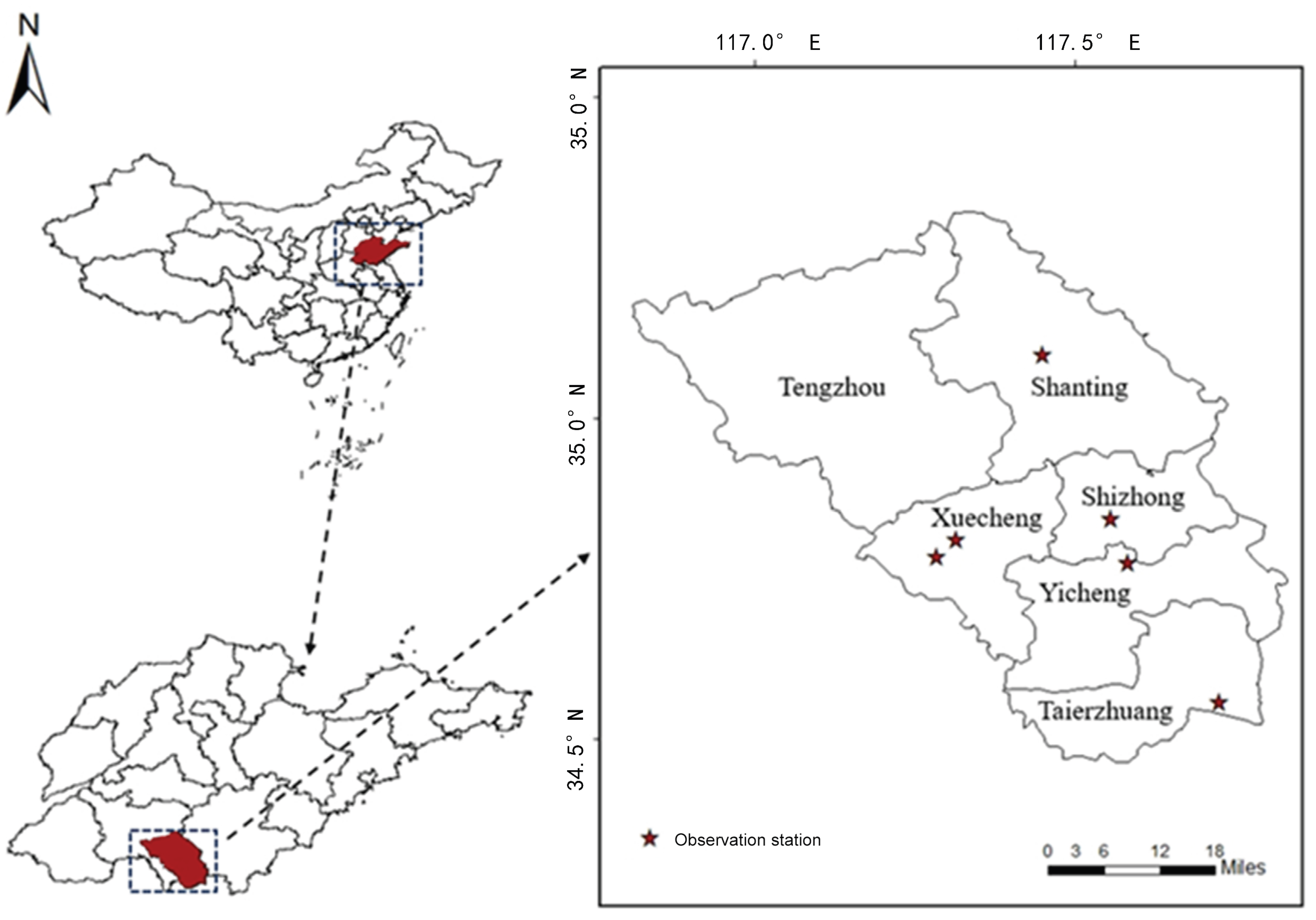
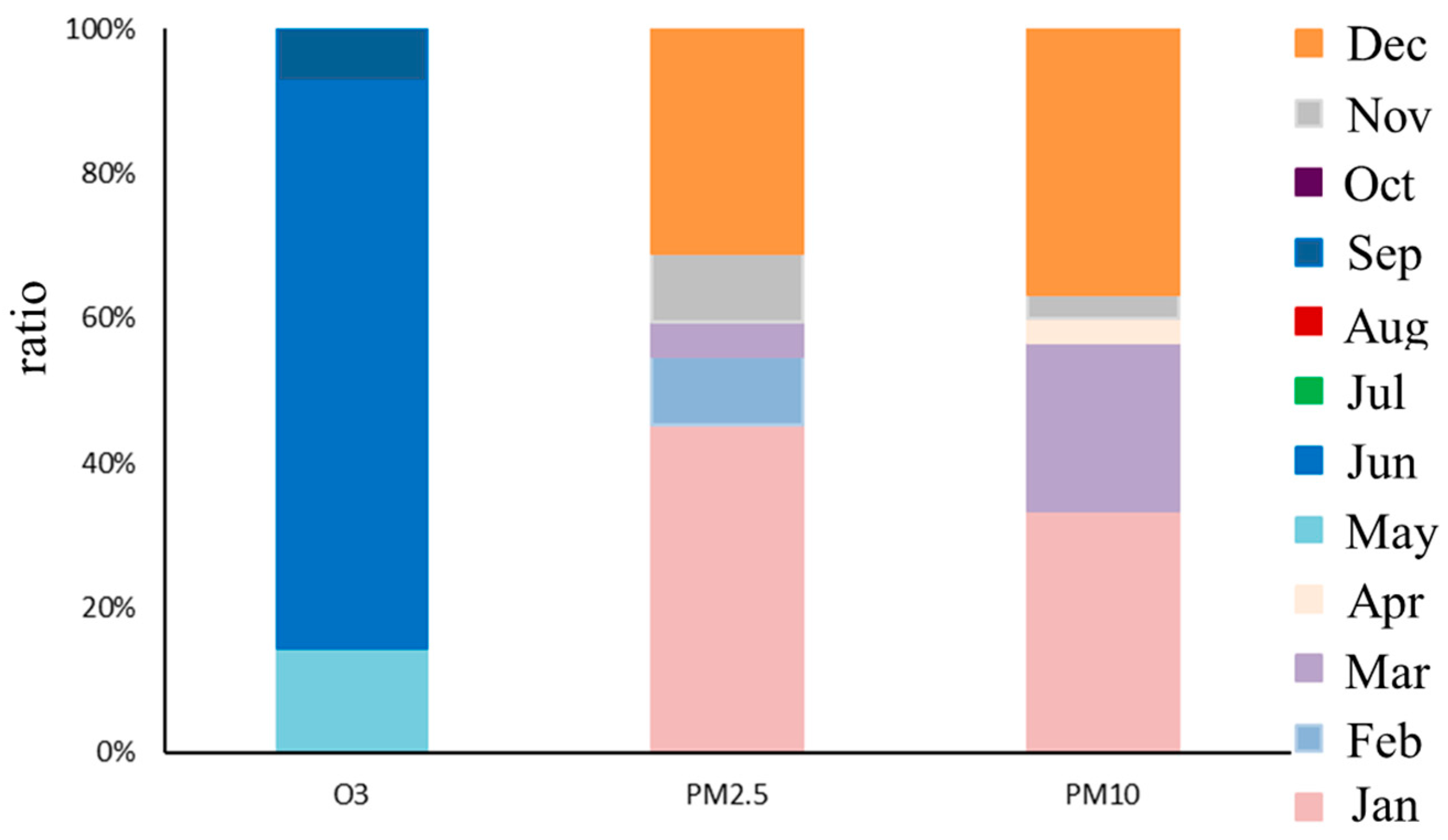
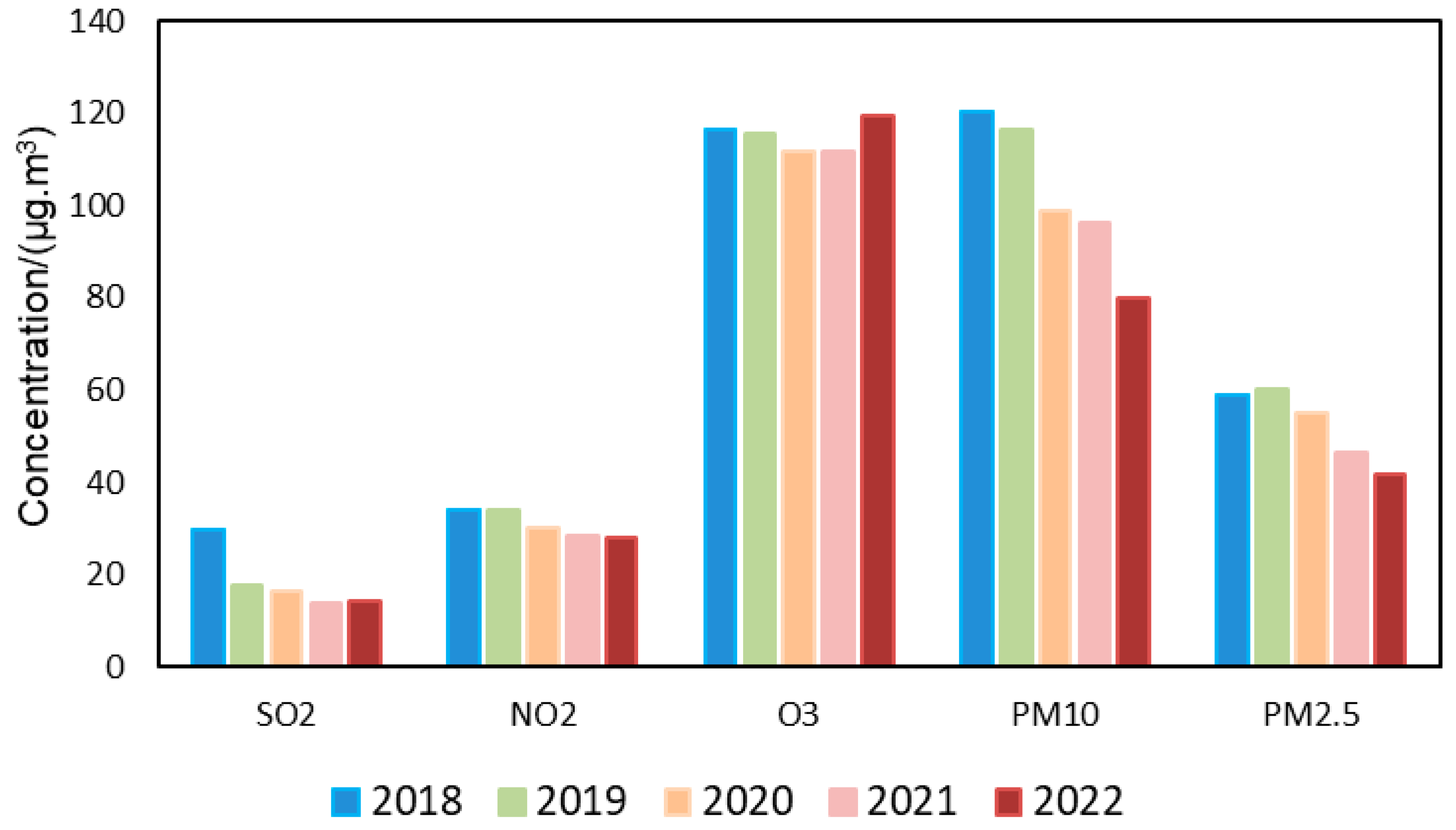
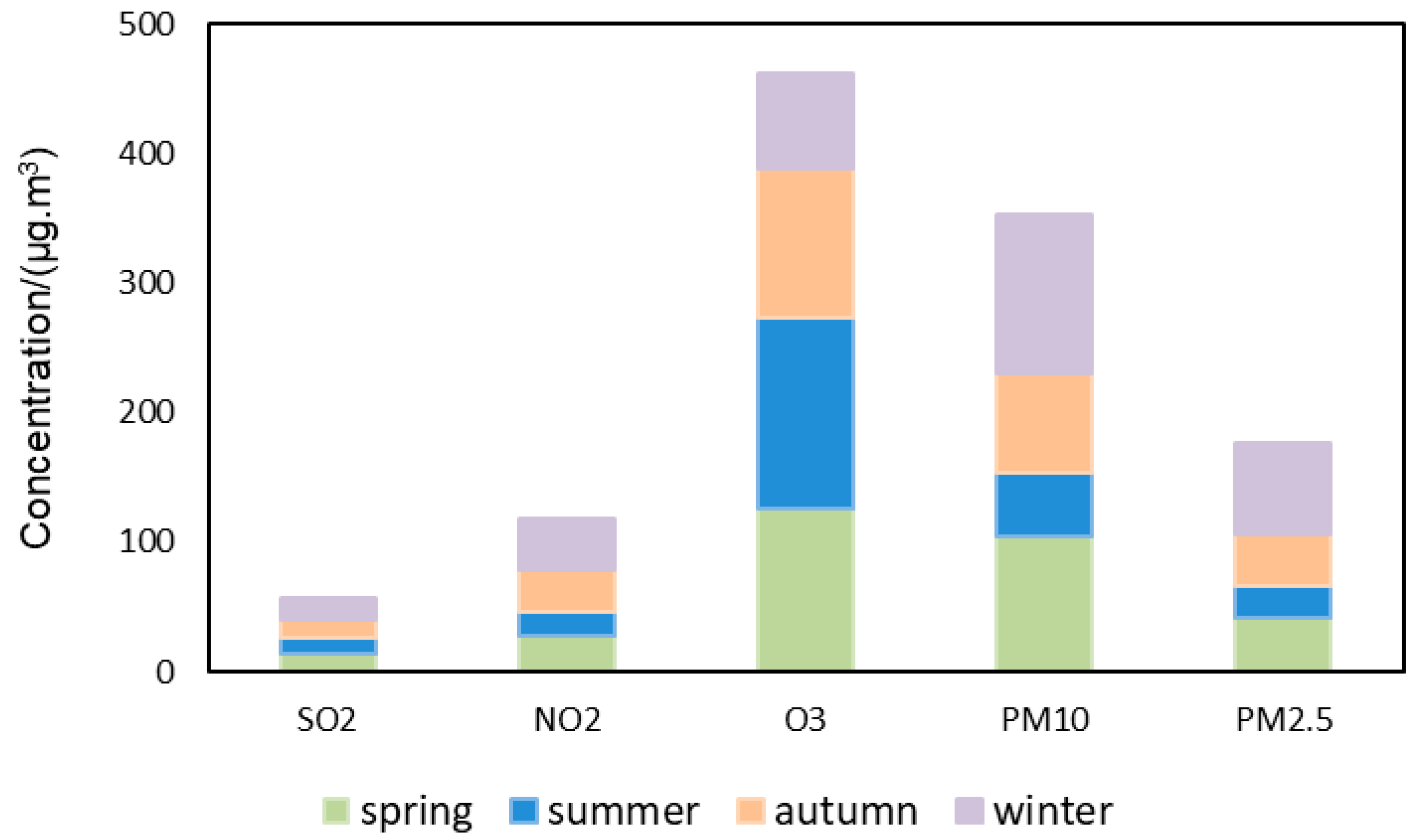
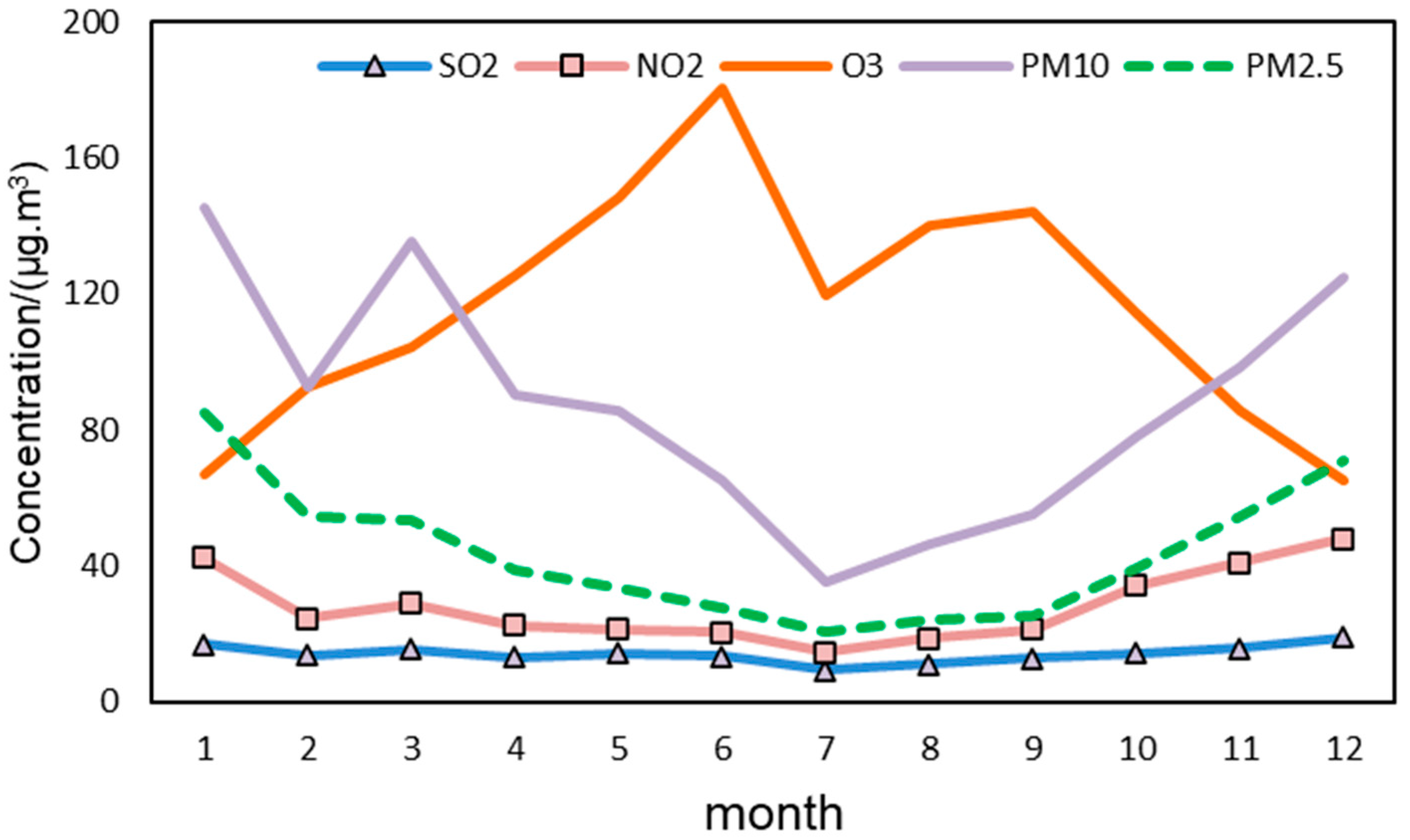

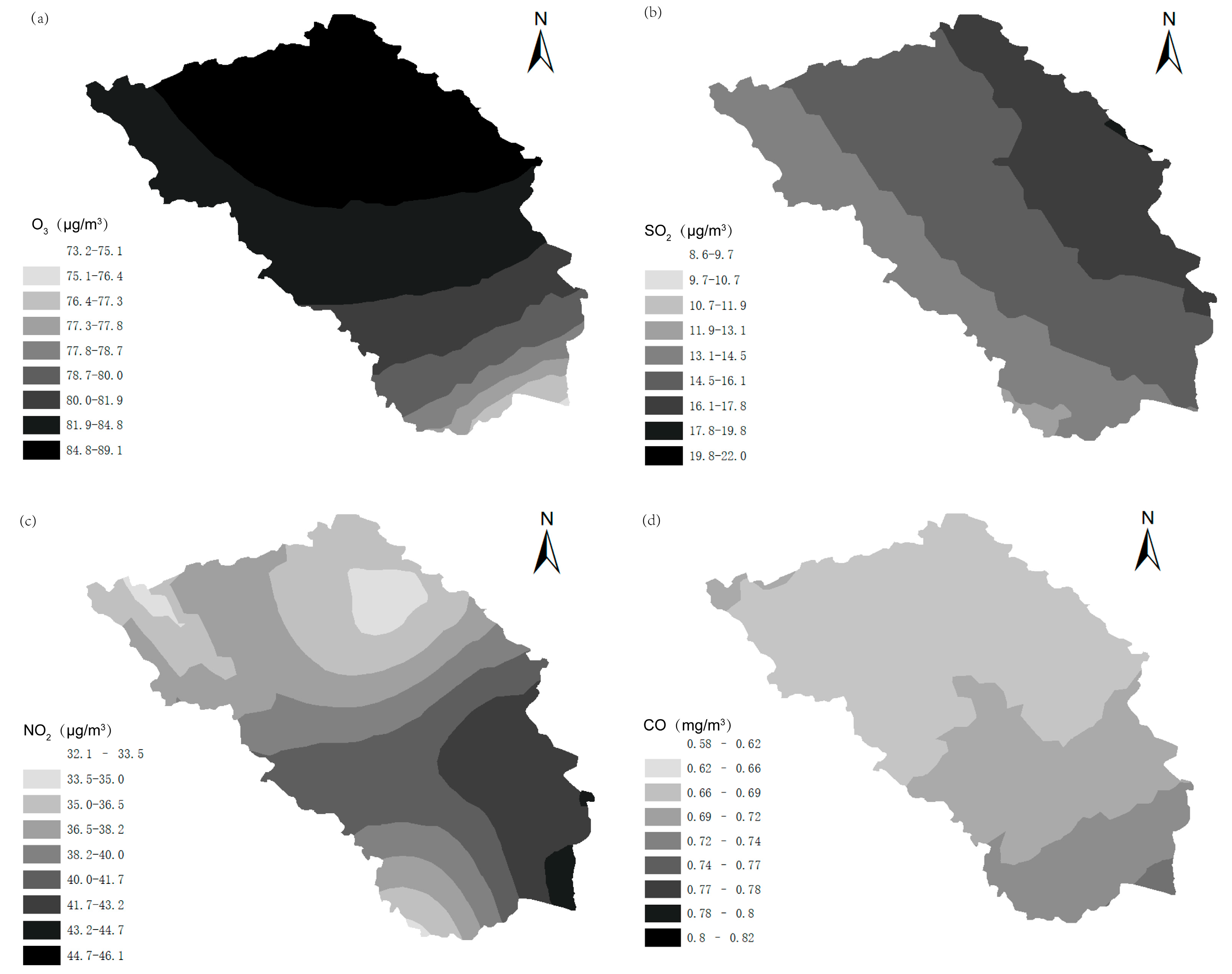

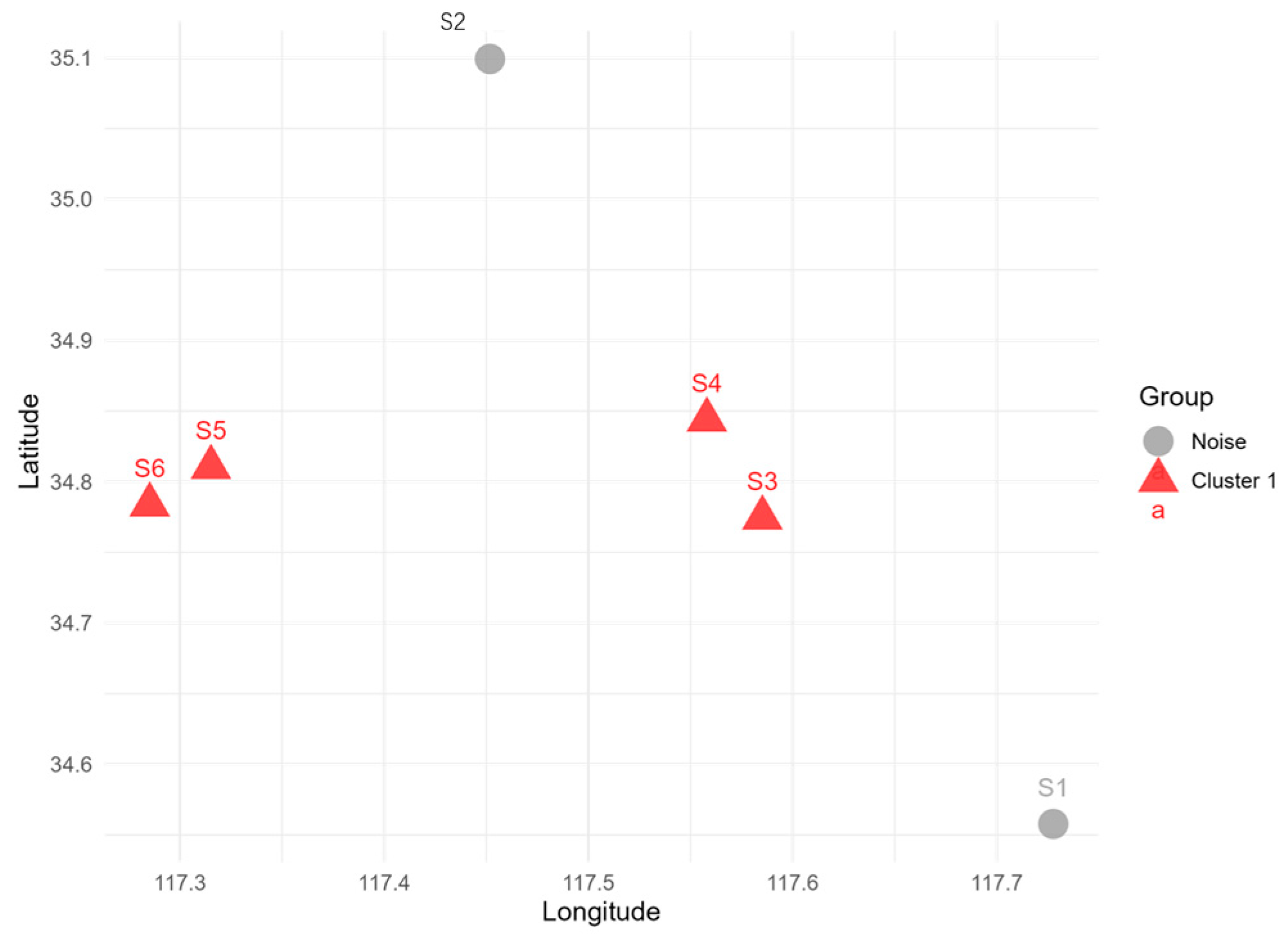
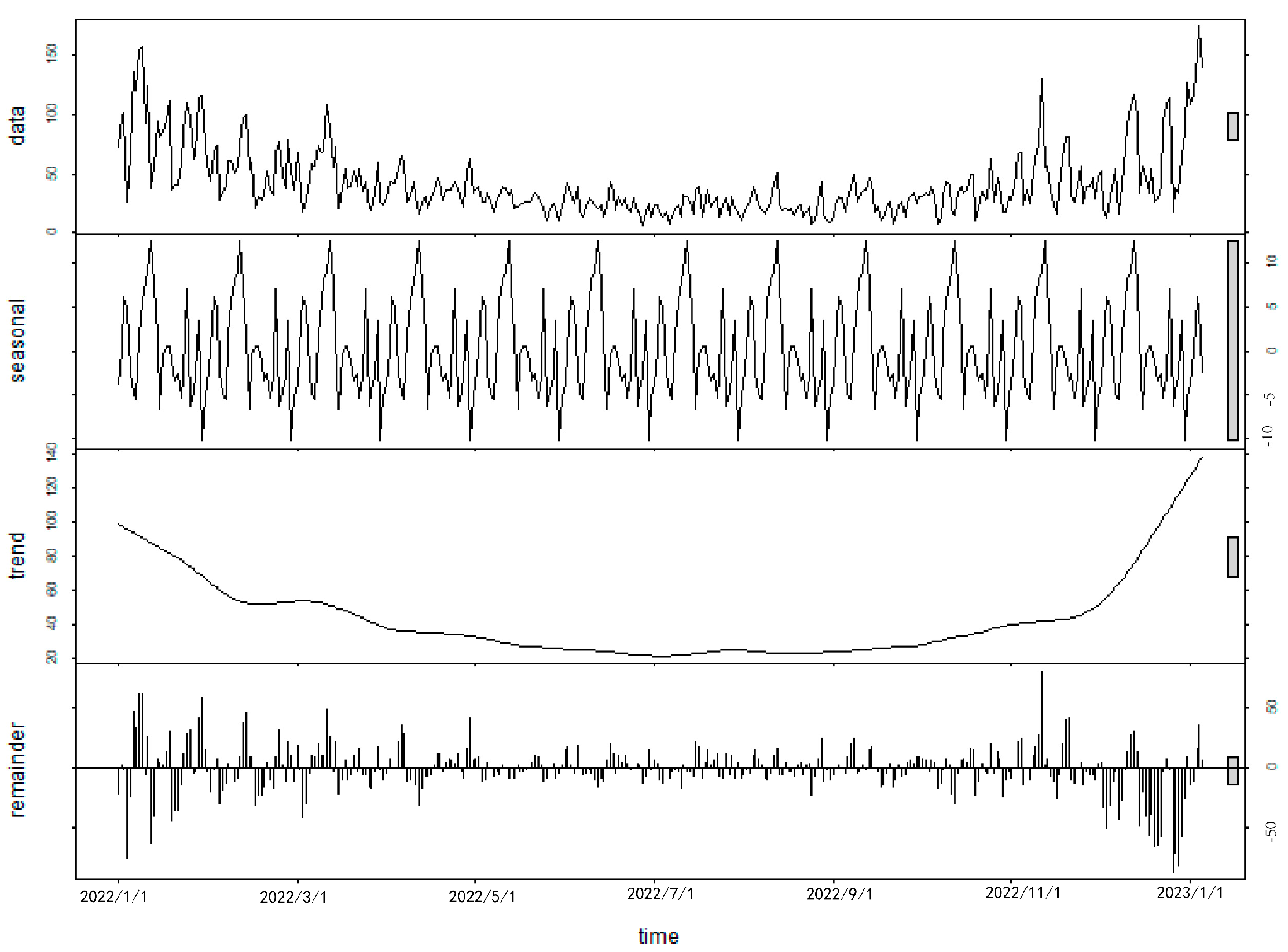
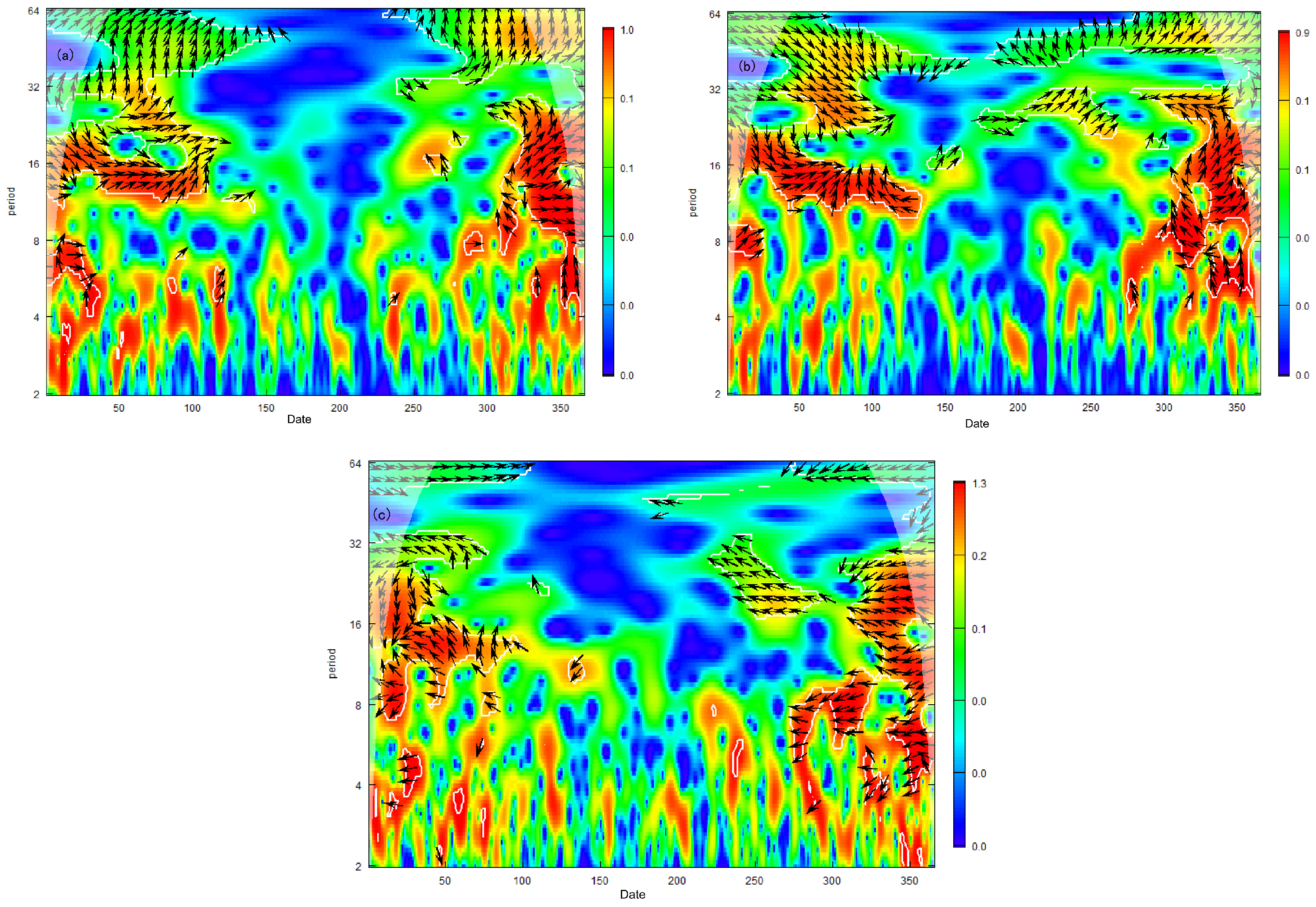
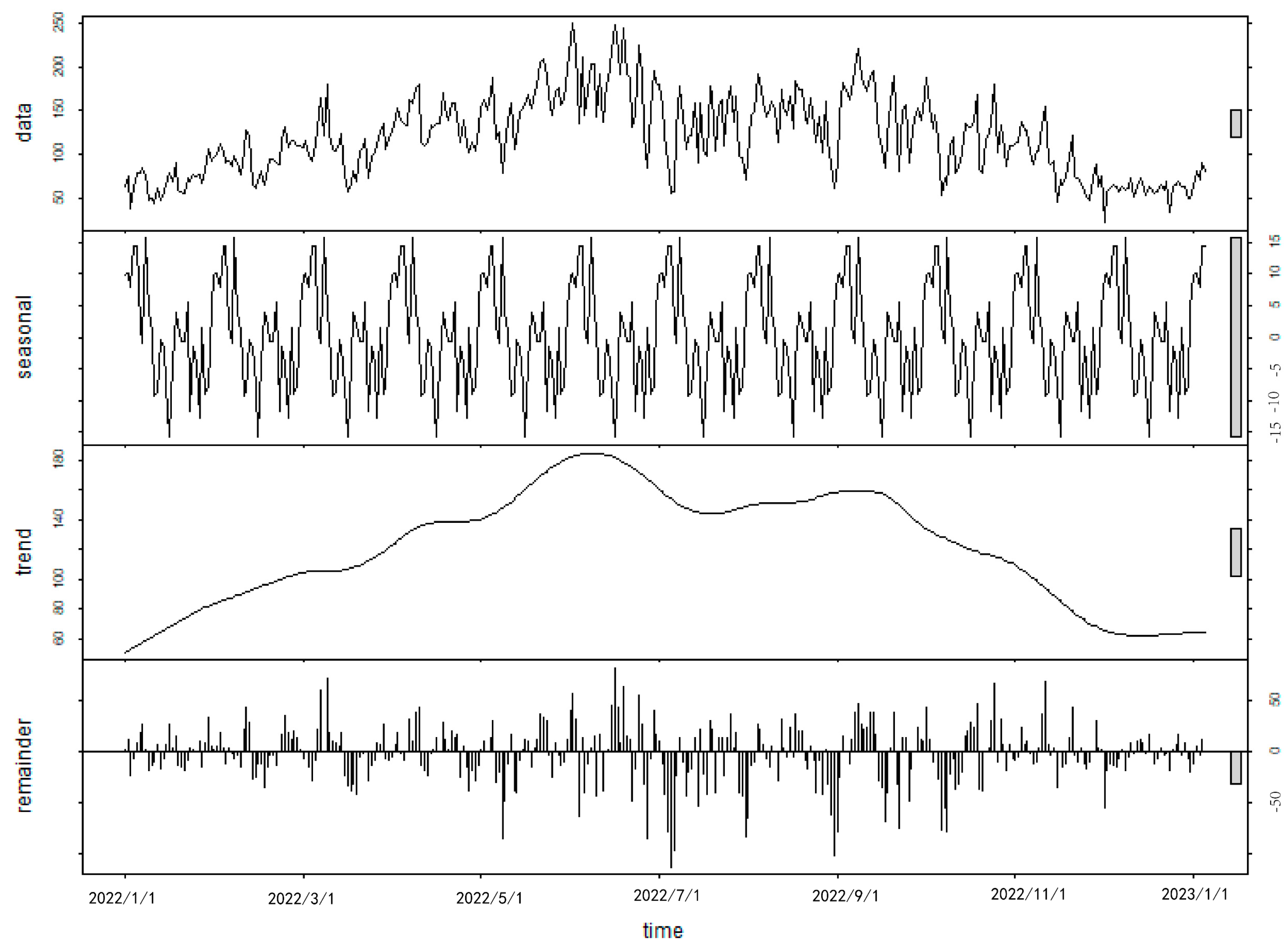
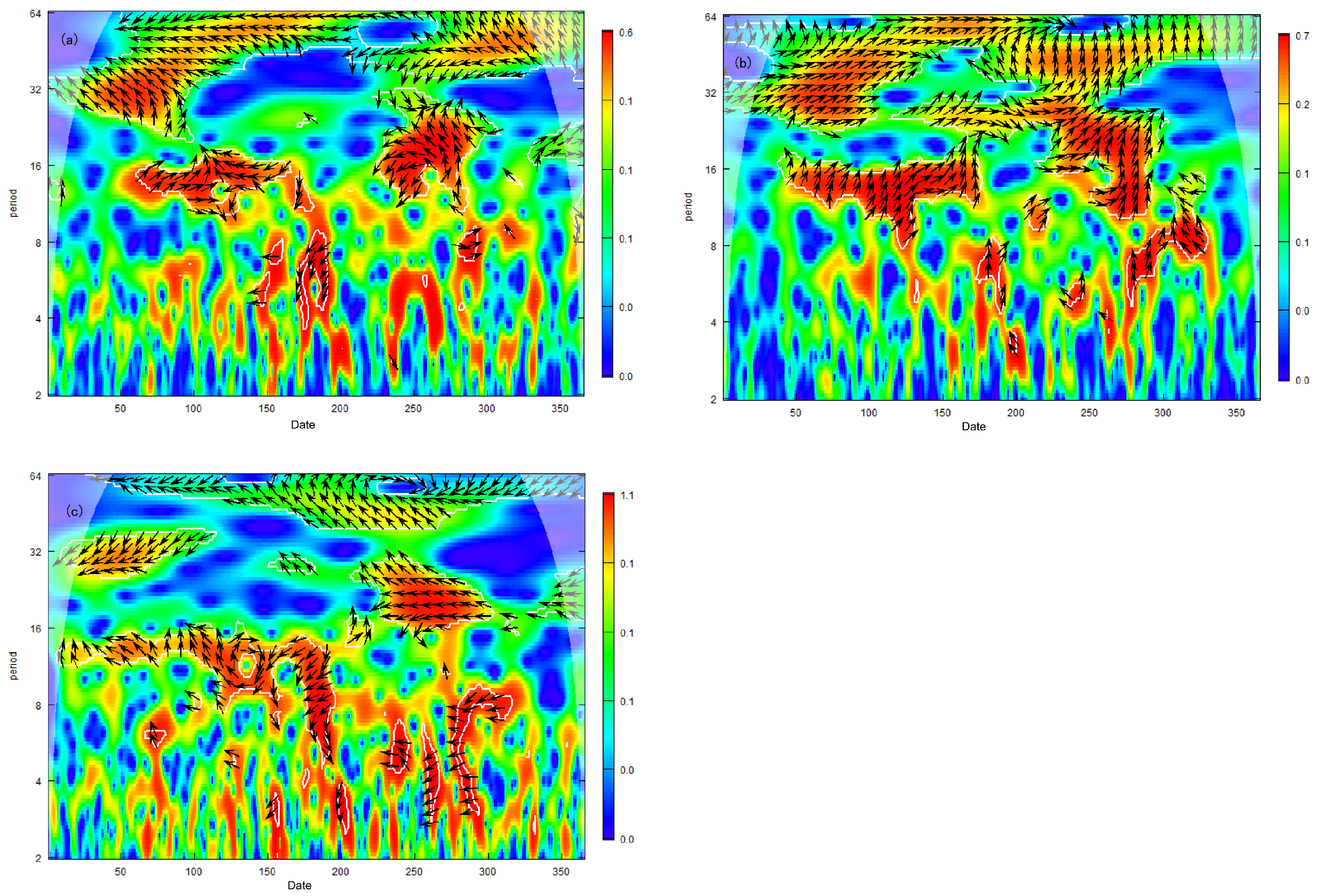
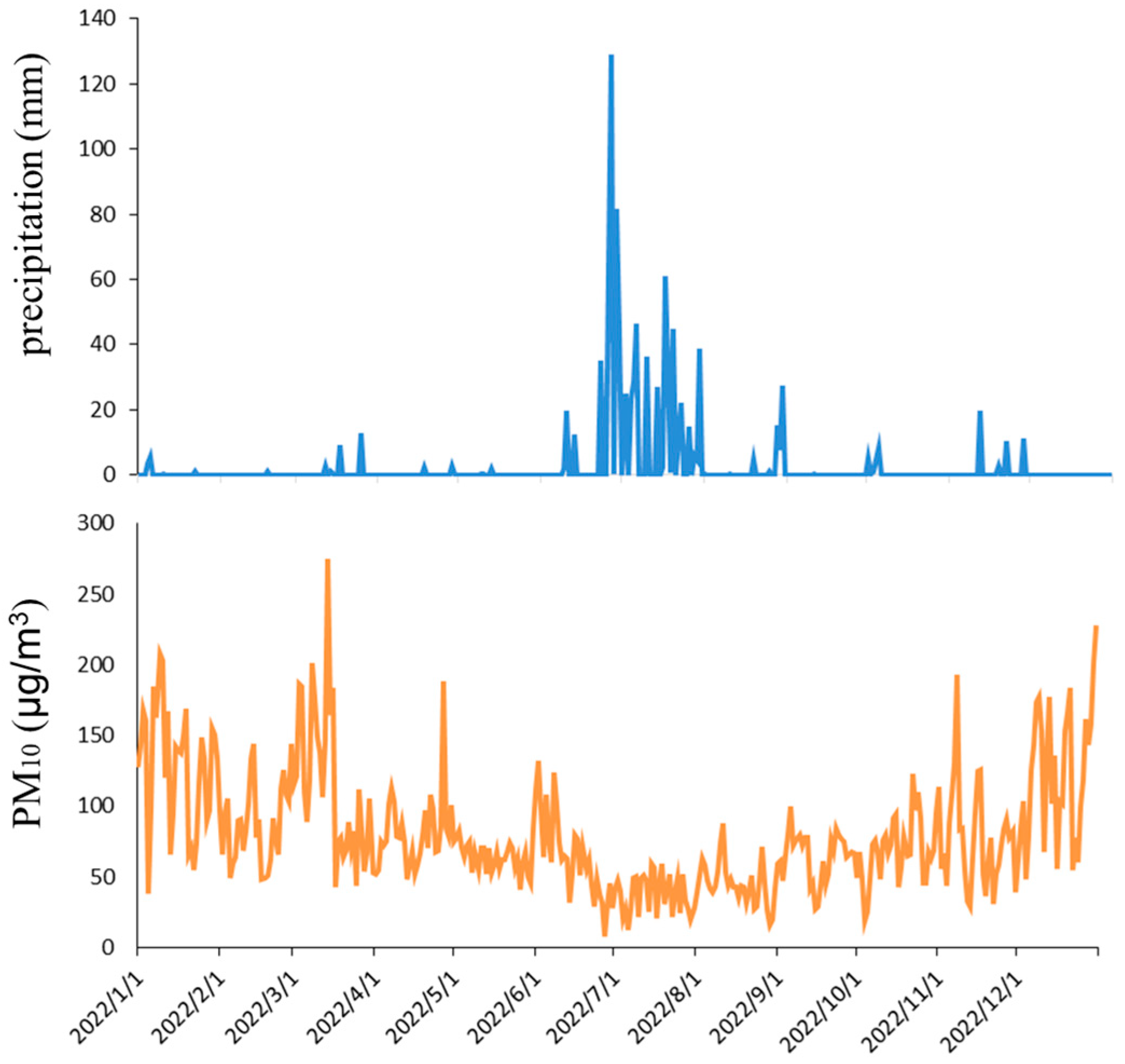
| Category | Exceedance Days | Total Days | Over-Standard Rate/% |
|---|---|---|---|
| O3 | 14 | 365 | 3.8 |
| CO | 0 | 365 | - |
| NO2 | 0 | 365 | - |
| SO2 | 0 | 365 | - |
| PM2.5 | 42 | 365 | 11.5 |
| PM10 | 30 | 365 | 8.2 |
| Pollutant | Spring | Summer | Autumn | Winter | Annual Mean |
|---|---|---|---|---|---|
| O3 | 126.3 ± 33.5 | 146.5 ± 47.0 | 114.6 ± 41.3 | 74.3 ± 18.8 | 115.6 ± 45.1 |
| CO | 0.554 ± 0.166 | 0.569 ± 0.128 | 0.648 ± 0.220 | 0.858 ± 0.257 | 0.631 ± 0.245 |
| NO2 | 28.2 ± 9.3 | 17.9 ± 4.7 | 32.8 ± 14.1 | 38.7 ± 14.9 | 28.3 ± 13.6 |
| SO2 | 14.2 ± 4.0 | 11.1 ± 3.0 | 14.2 ± 4.9 | 16.6 ± 5.2 | 14.0 ± 4.8 |
| PM2.5 | 41.8 ± 20.5 | 24.2 ± 9.6 | 39.8 ± 25.7 | 70.6 ± 35.4 | 44.0 ± 29.7 |
| PM10 | 104.1 ± 85.8 | 48.9 ± 23.0 | 77.4 ± 41.6 | 121.9 ± 49.7 | 88.0 ± 61.5 |
| Pollutant | Monday | Tuesday | Wednesday | Thursday | Friday | Saturday | Sunday | Max | Min |
|---|---|---|---|---|---|---|---|---|---|
| O3 | 114.8 | 116.6 | 122.8 | 123.3 | 125.6 | 117.2 | 121.2 | 114.8 (Monday) | 125.6 (Friday) |
| CO | 0.714 | 0.712 | 0.7 | 0.692 | 0.7 | 0.685 | 0.689 | 0.685 (Saturday) | 0.714 (Monday) |
| NO2 | 29.0 | 27.9 | 27.7 | 27.2 | 27.8 | 27.3 | 27.4 | 27.2 (Wednesday) | 29.0 (Monday) |
| SO2 | 14.5 | 13.7 | 14.1 | 14.3 | 14.0 | 13.8 | 14.4 | 13.7 (Tuesday) | 14.5 (Monday) |
| PM2.5 | 44.6 | 42.5 | 40.7 | 37.6 | 40.0 | 39.0 | 39.1 | 37.6 (Thursday) | 44.6 (Monday) |
| PM10 | 83.8 | 83.3 | 82.5 | 73.4 | 75.8 | 75.2 | 75.1 | 73.4 (Thursday) | 83.8 (Monday) |
| Year | Number of Events | Average Value | Maximum Value | Median Value |
|---|---|---|---|---|
| 2018 | 8 | 208.5 | 249 | 208.5 |
| 2019 | 6 | 199 | 242 | 192 |
| 2020 | 3 | 200 | 205 | 203 |
| 2021 | 1 | 201 | 201 | 201 |
| Station ID | Station Name | DBSCAN Group | Geographic Coordinates | PM2.5 (µg/m3) | O3 (µg/m3) |
|---|---|---|---|---|---|
| S1 | Taierzhuang | 0 (noise) | (34.5578, 117.7276) | 67.89 | 77.70 |
| S2 | Shanting | 0 (noise) | (35.0992, 117.4518) | 55.89 | 89.06 |
| S3 | Yicheng | 1 | (34.7745, 117.5852) | 63.32 | 81.66 |
| S4 | Shizhong | 1 | (34.8438, 117.558) | 68.71 | 83.45 |
| S5 | Shihuanbaoju | 1 | (34.8103, 117.3152) | 62.71 | 81.96 |
| S6 | Xuecheng | 1 | (34.7837, 117.2852) | 64.10 | 81.58 |
| Season | Meteorological Factors | NO2 | O3 | SO2 | CO | PM2.5 | PM10 |
|---|---|---|---|---|---|---|---|
| spring | temperature | −0.29 a | 0.83 a | −0.06 | −0.29 a | −0.36 a | −0.23 a |
| wind speed | −0.37 a | −0.07 | −0.28 a | −0.29 a | −0.23 a | −0.03 a | |
| relative humidity | 0.06 | −0.28 a | −0.17 | 0.57 a | 0.61 a | 0.17 a | |
| summer | temperature | 0.11 | 0.46 a | 0.22 a | 0.21 a | 0.27 a | 0.25 a |
| wind speed | −0.27 a | −0.10 | −0.01 | −0.29 a | −0.33 a | −0.06 a | |
| relative humidity | −0.53 a | −0.68 a | −0.70 a | 0.01 | −0.11 a | −0.61 a | |
| autumn | temperature | −0.31 a | 0.73 a | 0.41 a | −0.30 a | −0.17 a | −0.09 a |
| wind speed | −0.54 a | −0.38 a | −0.46 a | −0.21 a | −0.34 a | −0.33 a | |
| relative humidity | 0.07 | −0.22 a | −0.34 a | 0.48 a | 0.34 a | −0.06 | |
| winter | temperature | 0.19 | 0.03 | −0.08 | 0.18 a | 0.20 a | 0.21 a |
| wind speed | −0.03 | −0.07 | 0.04 | −0.17 a | −0.14 a | −0.15 a | |
| relative humidity | −0.40 a | 0.37 a | −0.21 a | −0.21 a | −0.16 a | −0.17 a |
| Date | Precipitation/mm | PM10 of the Day (µg/m3) | PM10 of the Previous Day (µg/m3) | Rate of Change (%) |
|---|---|---|---|---|
| 25 March 2022 | 12.9 | 44 | 82 | 53.6 |
| 9 June–10 June 2022 | 21.6 | 74 | 124 | 59.7 |
| 23 June 2022 | 35 | 29 | 44 | 65.9 |
| 26 June–30 June 2022 | 128.9 | 8 | 62 | 12.9 |
| 10 July 2022 | 36.5 | 13 | 32 | 40.6 |
| 28 August–30 August 2022 | 49.6 | 16 | 71 | 22.5 |
| 22 November–23 November 2022 | 10.5 | 31 | 78 | 39.7 |
Disclaimer/Publisher’s Note: The statements, opinions and data contained in all publications are solely those of the individual author(s) and contributor(s) and not of MDPI and/or the editor(s). MDPI and/or the editor(s) disclaim responsibility for any injury to people or property resulting from any ideas, methods, instructions or products referred to in the content. |
© 2025 by the authors. Licensee MDPI, Basel, Switzerland. This article is an open access article distributed under the terms and conditions of the Creative Commons Attribution (CC BY) license (https://creativecommons.org/licenses/by/4.0/).
Share and Cite
Xia, X.; Sun, S. Analysis of Spatio-Temporal Variation Characteristics of Air Pollutants in Zaozhuang China from 2018 to 2022. Atmosphere 2025, 16, 493. https://doi.org/10.3390/atmos16050493
Xia X, Sun S. Analysis of Spatio-Temporal Variation Characteristics of Air Pollutants in Zaozhuang China from 2018 to 2022. Atmosphere. 2025; 16(5):493. https://doi.org/10.3390/atmos16050493
Chicago/Turabian StyleXia, Xiaoli, and Shangpeng Sun. 2025. "Analysis of Spatio-Temporal Variation Characteristics of Air Pollutants in Zaozhuang China from 2018 to 2022" Atmosphere 16, no. 5: 493. https://doi.org/10.3390/atmos16050493
APA StyleXia, X., & Sun, S. (2025). Analysis of Spatio-Temporal Variation Characteristics of Air Pollutants in Zaozhuang China from 2018 to 2022. Atmosphere, 16(5), 493. https://doi.org/10.3390/atmos16050493




